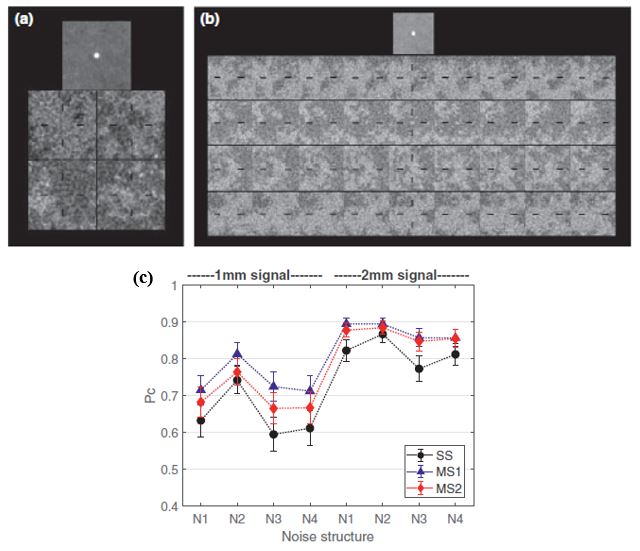글로벌 연구동향
의학물리학
- [Med Phys.] 이종 유방 콘빔 CT영상에서의 병변 검출성 평가 Evaluation of human observer performance on lesion detectability in single-slice and multislice dedicated breast cone beam CT images with breast anatomical background.
연세대 / 한민아, 백종덕*
- 출처
- Med Phys.
- 등재일
- 2018 Dec
- 저널이슈번호
- 45(12):5385-5396. doi: 10.1002/mp.13220. Epub 2018 Oct 24.
- 내용

Abstract
PURPOSE:
We evaluate the lesion detectability using human and model observer studies in single-slice and multislice cone beam computed tomography (CBCT) images with a breast anatomical background. The purposes of this work are (a) to compare human observer detectability between single-slice and multislice images for different signal sizes and noise structures, (b) to investigate the effect of different multislice viewing modes (i.e., sequential and simultaneous) on the detectability by a human observer, and (c) to predict the detectability by a human observer in single-slice and multislice images using single-slice channelized Hotelling observer (ssCHO) and multislice CHO (msCHO), respectively.METHODS:
Breast anatomical background is modeled using a power law spectrum of mammograms and the lesion is modeled with a spherical signal. We conduct signal-known-exactly and background-known-statistically detection tasks on transverse and longitudinal images reconstructed using the Feldkamp-Davis-Kress algorithm with Hanning and Ram-Lak weighted ramp filters. The human observer study is conducted on three different viewing modes: single-slice, and sequential and simultaneous multislice. To predict the detectability by a human observer, we use ssCHO and msCHO with anthropomorphic channels (i.e., dense difference-of-Gaussian (D-DOG) and Gabor channels) and internal noise.RESULTS:
The detectability by a human observer increases for multislice images compared to single-slice images. For multislice images, the sequential viewing mode yields higher detectability than the simultaneous viewing mode. However, the relative rank of detectability by a human observer for different signal sizes, image planes, and reconstruction filters is not much different between the viewing modes. Detectability by CHO with internal noise shows good correlation with that of the human observer for all viewing modes.CONCLUSIONS:
Detectability by a human observer in CBCT images with breast anatomical background is affected by the image viewing mode, and the effect of the viewing mode depends on the signal size and noise structure. D-DOG and Gabor CHO with internal noise predict the detectability by a human observer well for both the single-slice and multislice image viewing modes.
Author informationHan M1, Jang H1, Baek J1.
1
School of Integrated Technology and Yonsei Institute of Convergence Technology, Yonsei University, 162-1, Incheon, Korea.
- 키워드
- human observer; image quality; model observer; multislice; single-slice
- 덧글달기









